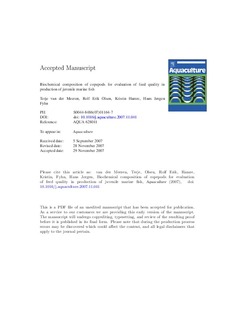| dc.description.abstract | To increase current knowledge on the nutritional value of natural prey organisms, the biochemical components of mainly three copepods (Acartia grani, Centropages hamatus, and Eurytemora affinis) from a marine pond system were analysed once a week from spring until late fall, over two years. The analysed components were total lipid, lipid class composition, total lipid fatty acid composition, free amino acids, total protein, protein-bound amino acids, pigment (astaxanthin and ß-carotene), and vitamins (A, thiamine, riboflavin, C, D3, and E). Copepod dry weight (DW), dry matter (% of wet weight), and ash content (% of DW) were also determined. The data are unique due to the homogenous content of copepods in the samples and the long time span of sampling. The copepods were characterised by moderate levels of lipids (6.9-22.5% of DW), with polar lipids accounting for 37.9 to70.2% of the total lipid. The most abundant fatty acids in total lipid (as % of total lipid) were 16:0 (palmitic acid, 10.8-17.1%), 20:5n-3 (EPA, 8.3-24.6%), and 22:6n-3 (DHA, 13.9-42.3%). The amount of 20:4n-6 (ARA) was generally low (0-2.6%), giving an EPA/ARA range between 7.5and 49.5. The DHA/EPA ratio was between 1.0 and 4.9. Free amino acids (FAA) constituted between 4.3 and 8.9% of copepod DW, and varied with salinity. Glycine, taurine, and arginine dominated FAA, and the fraction of indispensable amino acids varied between 15.5 and 26.8%. Protein, as back-calculated from the protein-bound amino acids (PAA), amounted to 32.7-53.6% of copepod DW, and contained a stable fraction of indispensable amino acids (37.3-43.2% of PAA). Glutamine/glutamic acid, asparagine/aspartic acid, leucine, alanine, and glycine were the most abundant PAA. Astaxanthin was abundant in the copepods (413-1422 μg/g DW), while ß-carotene was not found. High but variable concentrations of vitamin C (38-1232 μg/g DW) and vitamin E (23-209 μg/g DW) were found, while vitamin A and D3 occurred in trace amounts or were not detected. Detectable levels were found
for both thiamine (3.5-46.0 μg/g DW) and riboflavin (23.2-35.7 μg/g DW). The data may generate an important base for improvement of live feed enrichment emulsions or formulated feeds used during larval and early juvenile stages in marine fish culture. | en |
